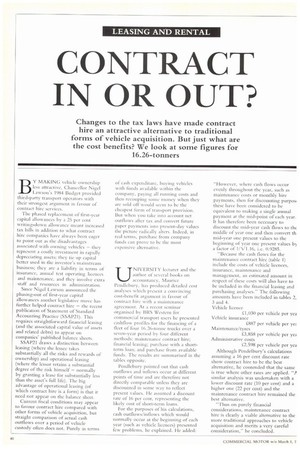CONTRACT IN OR OUT?
Page 40

If you've noticed an error in this article please click here to report it so we can fix it.
Changes to the tax laws have made contract hire an attractive alternative to traditional forms of vehicle acquisition. But just what are the cost benefits? We look at some figures for 16.26-tonners
BY MAKING vehicle ownership less attractive, Chancellor Nigel Lawson's 1984 Budget provided third-party transport operators with their strongest argument in favour of contract hire services.
The phased replacement of first-year capital allowances by a 25 per cent writing-down allowance meant increased tax bills in addition to what contract hire companies have always been eager to point out as the disadvantages associated with owning vehicles — they represent a costly investment in rapidly depreciating assets; they tie up capital better used in the investor's mainstream business; they are a liability in terms of insurance, annual test operating licences and maintenance, and they involve extra staff and resources in administration.
Since Nigel Lawson announced the phasing-out of first-year capital allowances another legislative move has Further helped contract hire — the recent publication of Statement of Standard Accounting Practice (SSAP21). This requires straightforward financial leasing (and the associated capital value of assets and related debts) to appear on companies' published bahince sheets.
SSAP21 draws a distinction between leasing (where the lessee takes substantially all the risks and rewards of ownership) and operational leasing (where the lessor retains a substantial degree of the risk himself — normally by granting a lease for substantially less than the asset's full life). The big advantage of operational leasing (of which contract hire is a form) is that it need not appear on the balance sheet.
Current fiscal conditions may appear to favour contract hire compared with other forms of vehicle acquisition, but straight comparison of actual cash outflows over a period of vehicle custody often does not. Purely in terms of cash expenditure, buying vehicles with funds available within the company, paying all running costs and then recouping sonic money when they are sold off would seem to be the cheapest form of transport provision. But when you take into account net outflows after tax and convert future paper payments into present-day values the picture radically alters. Indeed, in real terms, purchase from company funds can prove to be the most expensive alternative.
UNIVERSITY lecturer and the author of several books on accountancy, Maurice Pendlebury, has produced detailed cost analyses which present a convincing cost-benefit argument in favour of contract hire with a maintenance agreement. At a recent seminar organised by BRS Western for commercial transport users he presented cashflow profiles for the financing of a fleet of four 16.26-tonne trucks over a seven-year period by four different methods: maintenance contract hire; financial leasing; purchase with a shortterm loan; and purchase from available funds. The results are summarised in the tables opposite.
Pendlebury pointed out that cash outflows and inflows occur at different points of time and are therefore not directly comparable unless they arc discounted in sonic way to reflect present values. He assumed a discount rate of 16 per cent, representing the likely cost of short-term loans.
For the purposes of his calculations, cash outflows/inflows which would normally occur at the beginning of each year (such as vehicle licences) presented few problems, he explained. He added: "However, where cash flows occur evenly throughout the year, such as maintenance costs or monthly hire payments, then for discounting purpos, these have been considered to be equivalent to making a single annual payment at the mid-point of each year. It has therefore been necessary to discount the mid-year cash flows to tht middle of year one and then convert th mid-year one present values to the beginning of year one present values b) a factor of 1/V1.16, i.e. 0.9285.
"Because the cash flows for the maintenance contract hire (table 1) include the costs of vehicle licences, insurance, maintenance and management, an estimated amount in respect of these costs will also have to be included in the financial leasing and purchasing analyses." The following amounts have been included in tables 2, 3 and 4.
Vehicle licence £1,030 per vehicle per yea Vehicle insurance 1:887 per vehicle per ye Maintenance/tyres £3,858 per vehicle per yea Administrative costs £2,598 per vehicle per yea Although Pendelbury's calculations assuming a 16 per cent discount rate show contract hire to be the best alternative, he contended that the same is true where other rates are applied. "I". similar analysis was undertaken with a lower discount rate (10 per cent) and a higher one (22 per cent) and the maintenance contract hire remained the best alternative.
"Thus on purely financial considerations, maintenance contract hire is clearly a viable alternative to the more traditional approaches to vehicle acquisition and merits a very careful consideration," he concluded.




























































